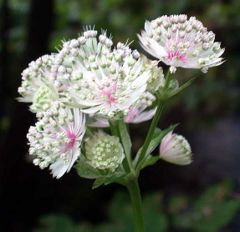Astrantia: Difference between revisions
No edit summary |
No edit summary |
||
| Line 1: | Line 1: | ||
{{SPlantbox | |||
|genus=Astrantia | |||
|Temp Metric=°F | |||
|jumpin=If this plant info box on watering; zones; height; etc. is mostly empty you can click on the edit tab and fill in the blanks! | |||
|image=Upload.png | |||
|image_width=240 | |||
}} | |||
{{Inc| | |||
Astrantia (name in allusion to star-like appearance of umbels). Umbelliferae. Masterwort. Perennial garden plants, grown for the odd and ornamental umbels and attractive habit. | |||
Glabrous and erect low herbs with dark-colored aromatic roots: Lvs. palmately lobed or dissected, petioled, the st.-lvs. often sessile and more simple: fls. polygamous, the sterile long-pedicelled and the fertile short-pedicelled; calyx with 5 foliaceous lobes, more or less tuberculate; petals oblong-ovate, connivent: fr. compressed. — Perhaps a half-dozen species, in Eu. and W. Asia, bearing fls. in leafy-involucred umbels and umbellules, the fls. being white, rose-colored or blush. The astrantias grow a foot or more high, making interesting branching plants for the border, particularly in moist places. Prop, by seeds, and easily by divisions in autumn or spring. | |||
}} | |||
__NOTOC__{{Plantbox | __NOTOC__{{Plantbox | ||
| name = ''Astrantia'' | | name = ''Astrantia'' | ||
Revision as of 15:49, 28 January 2010
| Astrantia subsp. var. | ||||||||||||||||||||||||||||||||||||||||||||||||||||||||
|---|---|---|---|---|---|---|---|---|---|---|---|---|---|---|---|---|---|---|---|---|---|---|---|---|---|---|---|---|---|---|---|---|---|---|---|---|---|---|---|---|---|---|---|---|---|---|---|---|---|---|---|---|---|---|---|---|

|
|
| ||||||||||||||||||||||||||||||||||||||||||||||||||||||
| ||||||||||||||||||||||||||||||||||||||||||||||||||||||||
| Standard Cyclopedia of Horticulture |
|---|
|
Astrantia (name in allusion to star-like appearance of umbels). Umbelliferae. Masterwort. Perennial garden plants, grown for the odd and ornamental umbels and attractive habit. Glabrous and erect low herbs with dark-colored aromatic roots: Lvs. palmately lobed or dissected, petioled, the st.-lvs. often sessile and more simple: fls. polygamous, the sterile long-pedicelled and the fertile short-pedicelled; calyx with 5 foliaceous lobes, more or less tuberculate; petals oblong-ovate, connivent: fr. compressed. — Perhaps a half-dozen species, in Eu. and W. Asia, bearing fls. in leafy-involucred umbels and umbellules, the fls. being white, rose-colored or blush. The astrantias grow a foot or more high, making interesting branching plants for the border, particularly in moist places. Prop, by seeds, and easily by divisions in autumn or spring.
|
Astrantia {{{latin_name}}}
|
'
| ||||||||||||||||||||||||||||||||||||||||
|---|---|---|---|---|---|---|---|---|---|---|---|---|---|---|---|---|---|---|---|---|---|---|---|---|---|---|---|---|---|---|---|---|---|---|---|---|---|---|---|---|---|

|
|
| |||||||||||||||||||||||||||||||||||||||
| |||||||||||||||||||||||||||||||||||||||||
- Do you have a description of this genus or plant? Edit this section!
Cultivation
| calendar? | ||
|---|---|---|
| January: | ||
| February: | ||
| March: | ||
| April: | ||
| May: | ||
| June: | ||
| July: | ||
| August: | ||
| September: | ||
| October: | ||
| November: | ||
| December: | ||
| Notes: | ||
- Do you have cultivation info on this plant? Edit this section!
Propagation
- Do you have propagation info on this plant? Edit this section!
Pests and diseases
- Do you have pest and disease info on this plant? Edit this section!
Species
Gallery
If you have a photo of this plant, please upload it! Plus, there may be other photos available for you to add.
-
photo 1
-
photo 2
-
photo 3
References
External links
- w:Astrantia. Some of the material on this page may be from Wikipedia, under the Creative Commons license.
- Astrantia QR Code (Size 50, 100, 200, 500)
